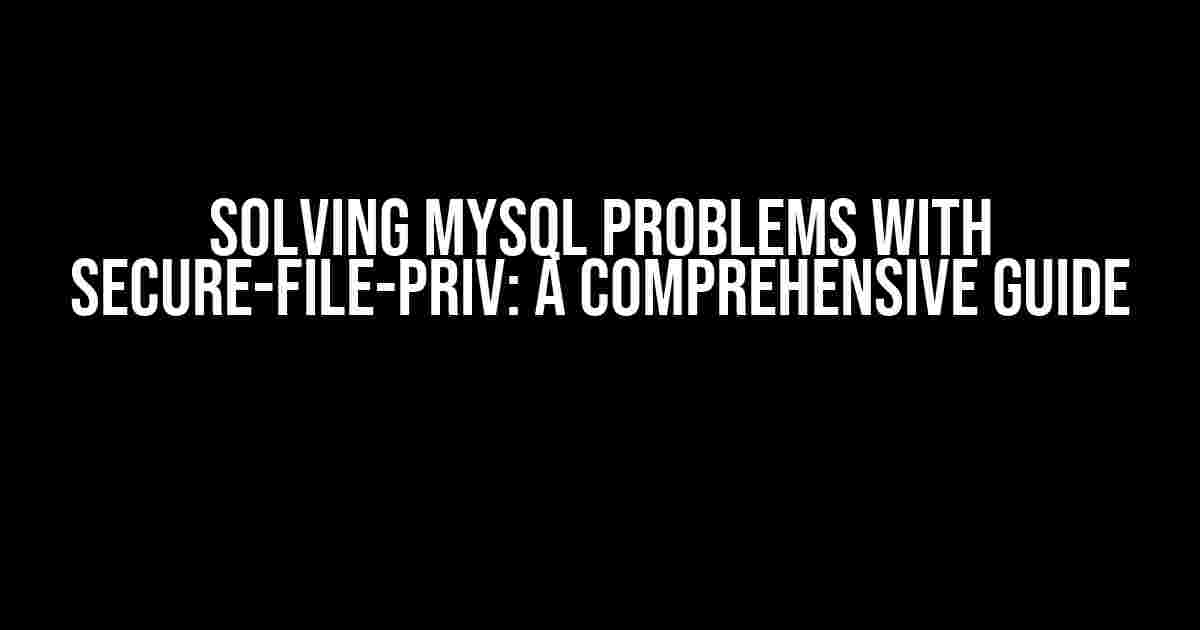MySQL, a popular open-source relational database management system, is widely used in web applications to store and manage data. However, when it comes to file imports and exports, MySQL can be a bit finicky. That’s where the secure-file-priv option comes in – a feature designed to enhance security by limiting the directories that can be read from or written to. But, with great power comes great responsibility, and sometimes, MySQL problems with secure-file-priv can arise. Fear not, dear reader, for this article will guide you through the common issues and provide solutions to get you back on track!
- What is Secure-File-Priv and Why Do I Need It?
- Solutions to Common MySQL Problems with Secure-File-Priv
- Error 1290: The MySQL server is running with the –secure-file-priv option so it cannot execute this statement
- FATAL ERROR: Could not read option file ‘/etc/my.cnf’ due to secure-file-priv restrictions
- Can’t read from file ‘/path/to/file.csv’ (errno: 1290)
- Can’t write to file ‘/path/to/file.csv’ (errno: 1290)
- Best Practices for Secure-File-Priv
- Conclusion
What is Secure-File-Priv and Why Do I Need It?
In MySQL, the secure-file-priv option is a security feature that restricts the directories that can be used for importing and exporting files. This option was introduced in MySQL 5.7.6 and is enabled by default. The main goal of secure-file-priv is to prevent unauthorized access to sensitive data and system files.
| Benefits of Secure-File-Priv |
|---|
| Limits access to sensitive data and system files |
| Prevents unauthorized imports and exports |
| Enhances overall database security |
While secure-file-priv is an excellent security feature, it can sometimes cause issues when not configured correctly or if not fully understood. Here are some common problems you might encounter:
- Error 1290: The MySQL server is running with the –secure-file-priv option so it cannot execute this statement
- FATAL ERROR: Could not read option file ‘/etc/my.cnf’ due to secure-file-priv restrictions
- Can’t read from file ‘/path/to/file.csv’ (errno: 1290)
- Can’t write to file ‘/path/to/file.csv’ (errno: 1290)
Solutions to Common MySQL Problems with Secure-File-Priv
Don’t panic! We’ve got you covered. Here are the solutions to the common problems listed above:
Error 1290: The MySQL server is running with the –secure-file-priv option so it cannot execute this statement
mysql> LOAD DATA INFILE '/path/to/file.csv' INTO TABLE mytable;
ERROR 1290 (HY000): The MySQL server is running with the --secure-file-priv option so it cannot execute this statement
Solution:
To resolve this error, you need to specify the directory that contains the file you want to import or export. You can do this by adding the secure_file_priv option to your MySQL configuration file (my.cnf or my.ini). For example:
[mysqld]
secure_file_priv=/path/to/secure/directory
Then, restart your MySQL server to apply the changes.
FATAL ERROR: Could not read option file ‘/etc/my.cnf’ due to secure-file-priv restrictions
Solution:
This error occurs when the MySQL server is not able to read the configuration file due to secure-file-priv restrictions. To resolve this issue, you need to add the configuration file directory to the secure_file_priv option:
[mysqld]
secure_file_priv=/etc/
Then, restart your MySQL server to apply the changes.
Can’t read from file ‘/path/to/file.csv’ (errno: 1290)
Solution:
This error occurs when the file you’re trying to import or export is not located in the directory specified by the secure_file_priv option. To resolve this issue, you can either:
- Move the file to the specified directory
- Update the
secure_file_privoption to include the directory that contains the file
Can’t write to file ‘/path/to/file.csv’ (errno: 1290)
Solution:
This error occurs when the file you’re trying to export is not located in the directory specified by the secure_file_priv option. To resolve this issue, you can either:
- Move the file to the specified directory
- Update the
secure_file_privoption to include the directory that contains the file
Best Practices for Secure-File-Priv
To avoid common MySQL problems with secure-file-priv, follow these best practices:
- Specify a secure directory: Choose a directory that is not accessible to unwanted users and only grants access to the MySQL user.
- Keep the secure directory clean: Avoid storing sensitive data or system files in the secure directory to prevent unauthorized access.
- Update the secure_file_priv option: Make sure to update the
secure_file_privoption in your MySQL configuration file to reflect changes to the secure directory. - Test your configuration: Verify that your secure-file-priv configuration is working as expected by testing imports and exports.
Conclusion
In conclusion, MySQL problems with secure-file-priv can be frustrating, but they’re easily solvable with the right knowledge and configuration. By following the best practices and solutions outlined in this article, you’ll be able to enjoy the benefits of secure-file-priv while avoiding common issues. Remember, security is not a one-time task, but an ongoing process. Stay vigilant, and happy MySQL-ing!
Still having issues? Leave a comment below, and we’ll do our best to help you troubleshoot the problem!
Frequently Asked Question
Get the inside scoop on solving MySQL problems with secure-file-priv!
What is secure-file-priv in MySQL and how does it affect my database?
Secure-file-priv is a security feature in MySQL that restricts the ability to read and write files on the server. It’s enabled by default in MySQL 5.7 and later versions. When secure-file-priv is enabled, MySQL can only read and write files in the directory specified by the secure_file_priv system variable. This feature helps prevent malicious attacks and data breaches. However, it can also cause issues when trying to import or export data, or perform certain database operations.
Why am I getting an error when trying to import a CSV file into MySQL with secure-file-priv enabled?
The error you’re seeing is likely because the CSV file is not in the directory specified by the secure_file_priv system variable. To resolve this, you can either move the CSV file to the secure directory or disable secure-file-priv (not recommended for security reasons). Alternatively, you can use the LOAD DATA INFILE statement with the LOCAL keyword, which allows you to specify a local file path, bypassing the secure-file-priv restriction.
How do I configure the secure_file_priv system variable in MySQL?
To configure the secure_file_priv system variable, you’ll need to edit the MySQL configuration file (typically my.cnf or my.ini). Add the following line to the [mysqld] section: secure_file_priv = “/path/to/secure/directory”. Restart the MySQL server after making the change. Alternatively, you can set the variable dynamically using the SET GLOBAL statement, but this will only apply until the server is restarted.
Can I disable secure-file-priv in MySQL for convenience?
We strongly advise against disabling secure-file-priv, as it’s a crucial security feature that helps prevent malicious attacks and data breaches. Disabling it would allow an attacker to access sensitive files on the server, compromising the security of your database. Instead, configure the secure_file_priv system variable to specify a secure directory for file operations.
Are there any alternative solutions to work around secure-file-priv limitations?
Yes, there are alternative solutions to work around secure-file-priv limitations. For example, you can use MySQL’s built-in encryption features to encrypt data at rest and in transit. You can also use external tools and libraries to handle file operations, such as mysqlimport or mysqlpump, which can bypass secure-file-priv restrictions. Additionally, consider using cloud-based or managed database services that provide built-in security features and flexible data management capabilities.



